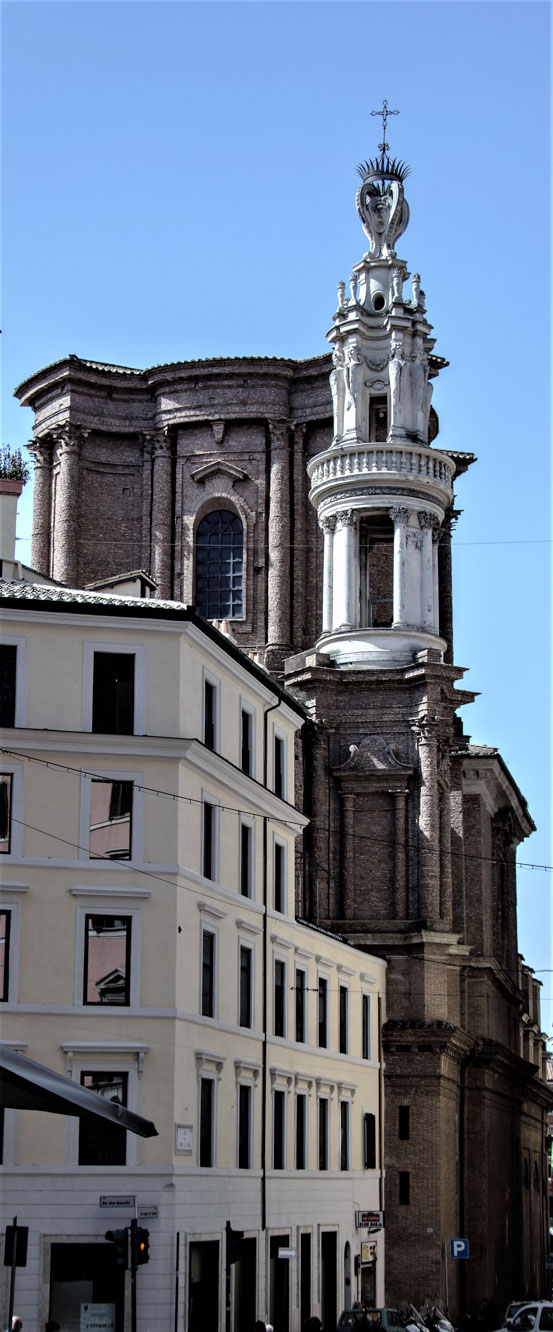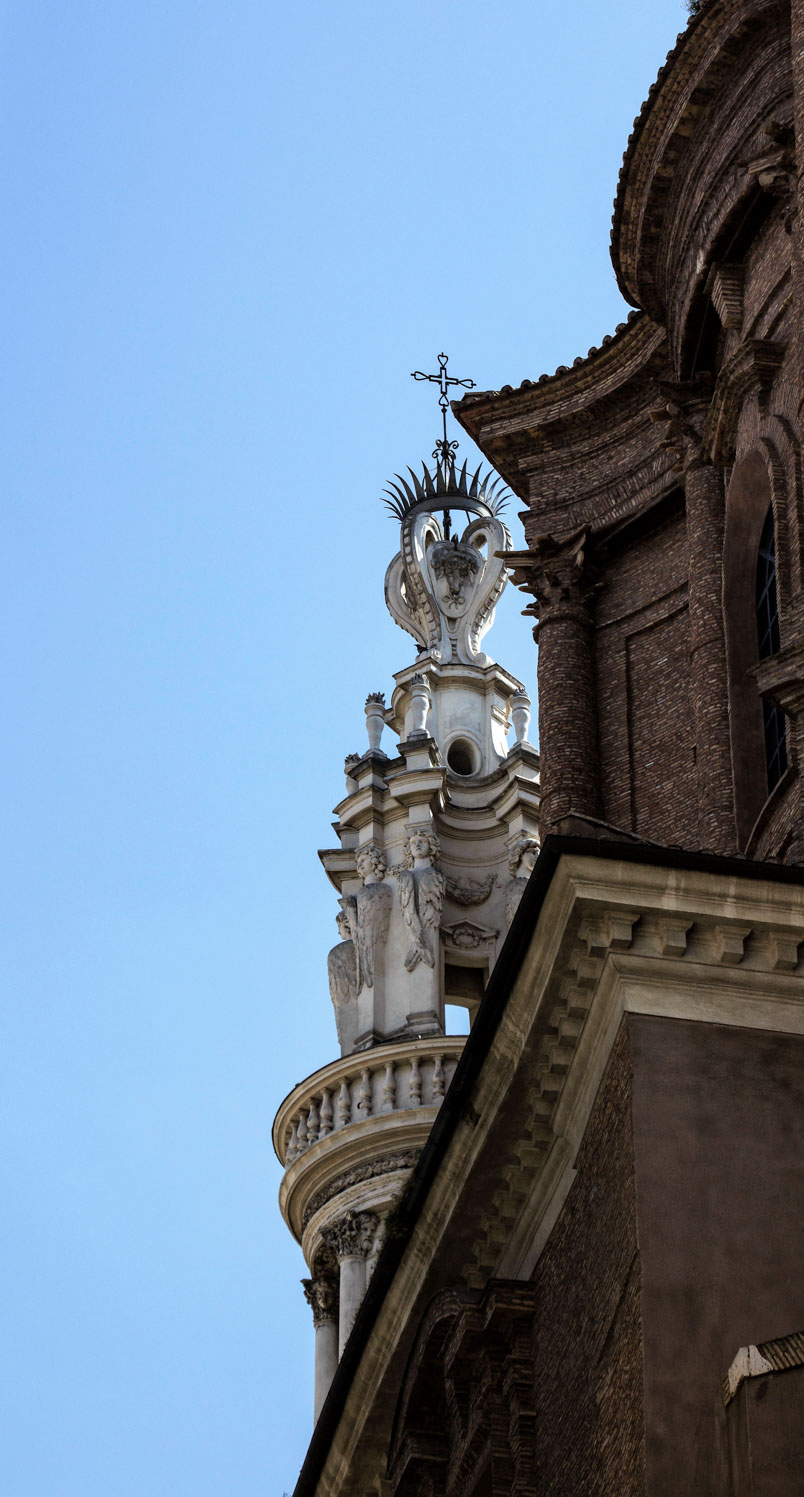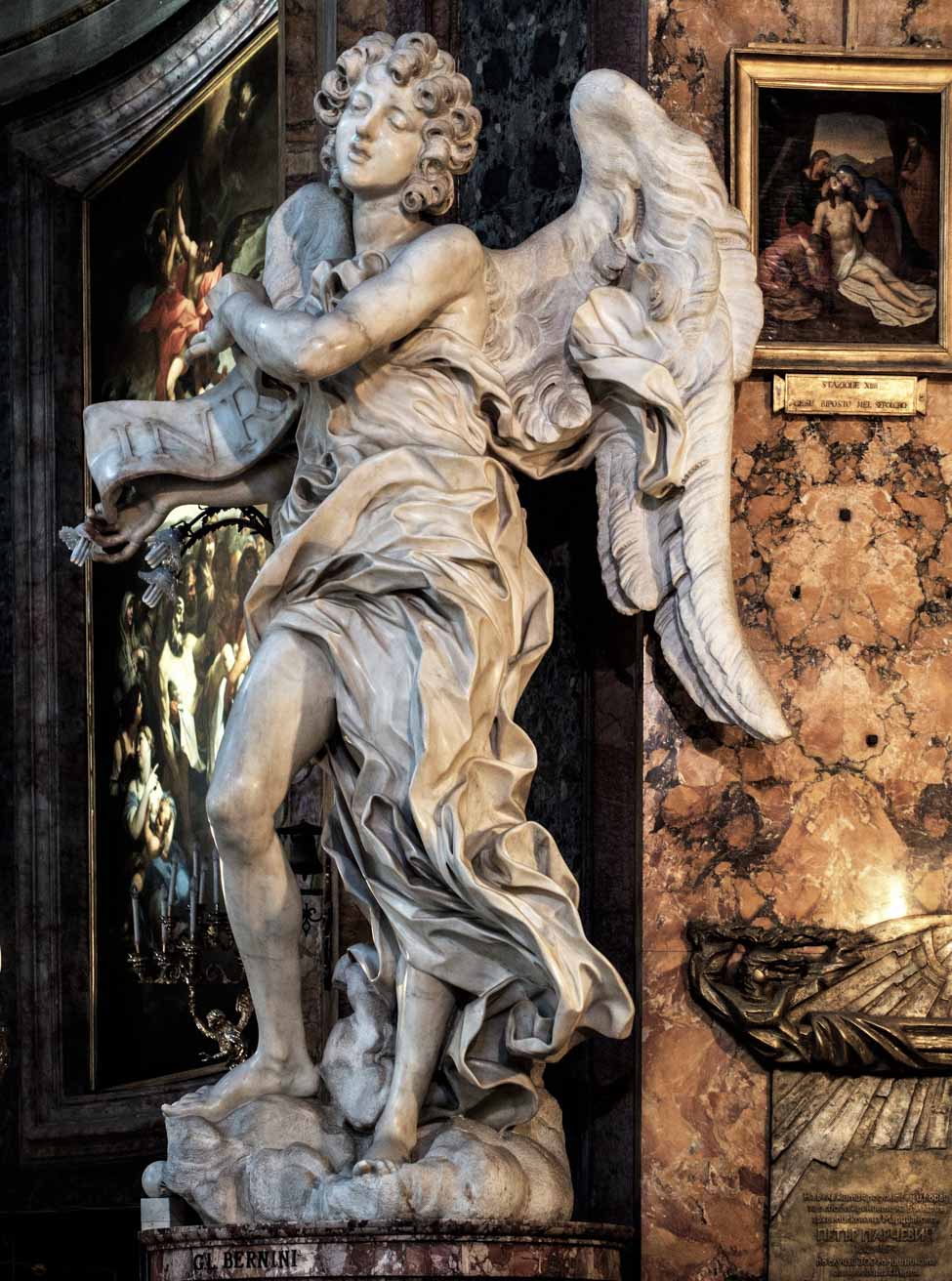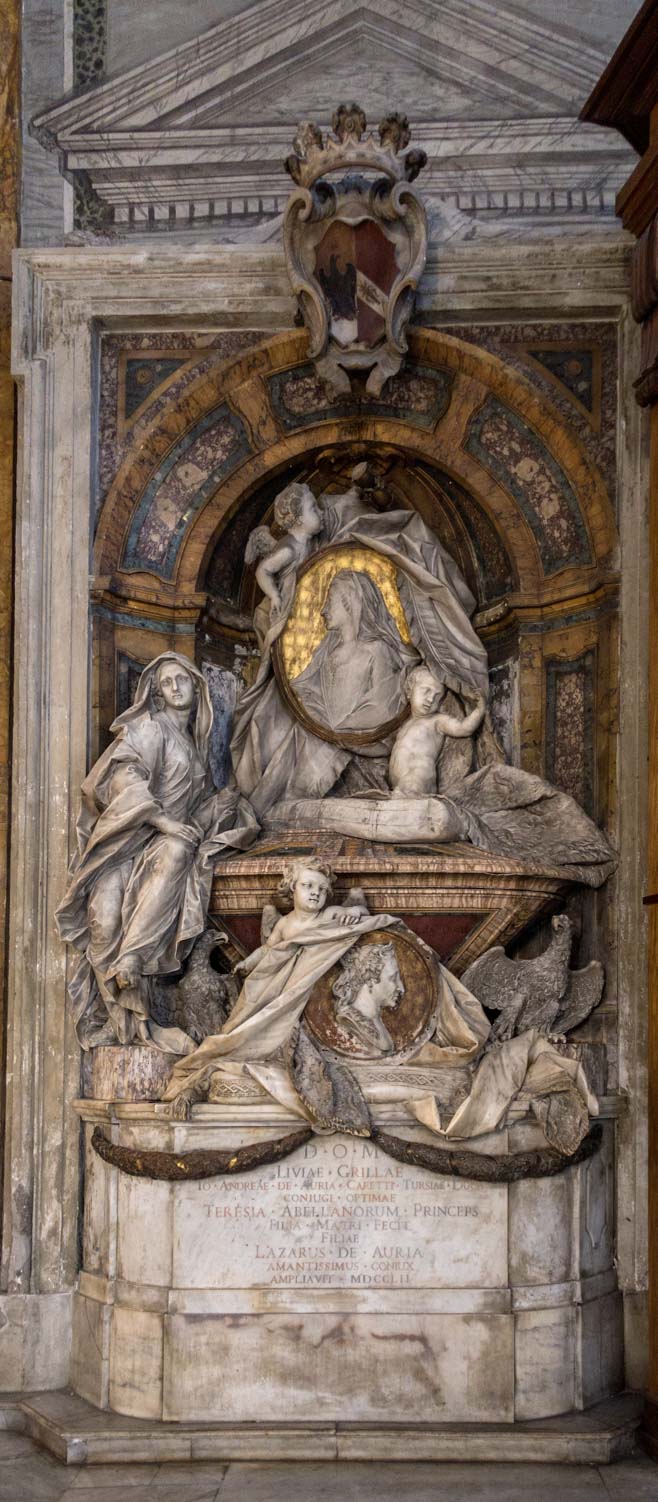
BUDOWLE & OBIEKTY Churches and chapels
Church of Sant’Andrea delle Fratte – where posthumously Bernini struggles with Borromini

Before this imposing church was constructed, as early as the Middle Ages a chapel devoted to St. Andrew was located here. In the past in was a sparsely populated area, overgrown with bushes, behind which vineyards stretched. This is where the name of the church came from, which may be translated as the Church of St. Andrew in the Bushes. Pope Sixtus V entrusted this church, in 1585, to the Order of the Minims, established by Francis of Paola (Francesco di Paola) – a monk and ascetic, at the beginning of the XVI century canonized as a saint. After the order came to Rome monastic arrangements were built, including the cloisters still in existence today, while in 1605 the old church was torn down. In its place a new one was to be put up. However, the financial resources, which the monks possessed quickly ran out and the completion of the church was put in question. Then, help came from Ottavio del Bufalo, who lived nearby. In exchange for the possibility of erecting a monumental tombstone statue for himself and his family he financed further works. The architect, who took up the task, was the little-known Gaspare Guerra, from Modena, who planned a single-nave space, opening up towards the side chapels, finished off with a dome in the part of a short transept. After the death of the funder, financing was taken up by his brother Angelo del Bufalo, but in 1617 works on the church were halted. It was not until over thirty years later that at the order of Paolo, the son and the principal inheritor of Ottavio, the renowned architect, Francesco Borromini, was tasked with finishing the construction. Paolo assigned the funds necessary to finalize the transept planned by Guerra, the dome filled with windows and the apse. He insisted on the works being completed according to the old plan, not wanting a new design, to which Borromini finally, albeit hesitantly, agreed. On the other hand in shaping the external structure, the funder let the architect do as he pleased. Here, the ambitious architect was able to display his original talent and it must be said that he did all he could, to leave a mark of his artistic personality on this structure. A testimony to his originality was among others finishing off the dome with a never seen before in Rome tower of hollow and bulging shape, reminiscent in its plan to the Cross of St. Andrew (X) and additionally decorated with brick columns with capitols in the form of what looked like tongues more than any other artistic elements. It is best to look upon them from the monastic viridary belonging to the church. Perhaps the whole was to be covered with snow-white stucco, same as the one visible on the top of the bell tower found next to the choir (1659), one of the most recognizable and original works of Borromini in Rome – that is why it is worth devoting a few additional sentences to it. This top consists of three gradually narrowing elements reminiscent in shape of an antique temple. On the first level it is decorated with Janus heads, not seen from afar, inserted into the capitols, depicting young and old men, which on the second level are supplemented by figures of stylized angels with folded wings. As if this was not enough, above their heads, on part of the entablature, the architect placed eight urns, from which rays seem to protrude. The last part consists of four volutes, between which elements of the coat of arms of the clients are visible, meaning the Bufalo family (a head of the buffalo). A good view of the bell tower can be had from the perspective of the street on the other side of the aforementioned viridary, although the best view stretches from the Spanish Steps – from that vantage point, the strange, urn-like bell tower is best seen. Unfortunately Borromini, once again was not able to finish his work. As we know, the artist beset by depression committed suicide. After his death, works on the church were continued by Matteo de Rossi, however, lack of funds once again halted the construction. It was not completed until 1826, when a modest brick façade decorated with elements of stucco and travertine was made.

The interior was actually completed at the end of the XVII century and it contains typical for late Baroque painting and ornamental decorations, which were later supplemented in the XVIII and XIX centuries. The whole, which is reminiscent, on a smaller scale of course, of the Church of Il Gesù, was laid out with marble flooring and decorated with Ionian pilasters supporting the decorative cornice, which are separated from one another by the chapels. The main nave is topped off with a barrel vault. The high dome with large windows, as well as the pendentives, is decorated with painting of Andrea Pasquale Marini, depicting the Assumption of Our Lady. The broad main nave, opens up on both sides onto the chapels adjacent to it. In them, on the main altar and on the walls and pilasters there are objects of significant artistic value, although we will not find any exceptional works here, apart from those already mentioned, in all few of the lesser known works of Bernini and Borromini – two masters of the Baroque and great rivals.
Let us devote some attention to the works of Bernini, since they are the ones who generally draw tourists to this church. Two monumental statues of angels, flanking the apse, were only placed here in 1826. Initially destined for the embellishment of Ponte Sant’Angelo (Bridge of the Holy Angel), they were made in 1669 by the master himself. They were part of a group of angels of which the rest was entrusted to Bernini’s apprentices and associates. The angel with a crown of thorns and the other with the inscription INRI (Iesus Nazarenus Rex Iudaeorum), aroused such great admiration of Pope Clement IX, that he ordered copies to be placed on the bridge, while the originals were left in the artist’s workshop at the disposal of the papal nephew, Cardinal Giacomo Rospigliosi. Most likely, the nepot intended to decorate his palace with them, but in the end this did not occur. For subsequent centuries, both sculptures belonged to Bernini’s successors, all the way to the XIX century when the family decided to give them to the Church of Sant’Andrea della Fratte, opposite to which, the master lived and worked in an imposing tenement house (commemorated by a plaque). Thanks to this gift, paradoxically even in death Bernini crossed paths with Francesco Borromini, who in life was jealous of his fame and success. The church is visited not so much and not only due to the architecture of Borromini but more so due to Bernini’s angels.
Let us once again stop in the interior. The apse of the church, widely opening up onto the interior, is richly decorated with paintings. In the niche which tops it off, we will see frescos of Andrea Pasquale Marini, depicting scenes from the Gospel of St. John, in which Christ feeds five thousand men, having at his disposal five loaves of bread and two fish, brought to him by a small boy. In the rotund itself, we will find three monumental scenes showing the martyrdom and death of St. Andrew. The painters responsible for them are the XVII and XVIII-century artists: Battista Leonardi, Lazzaro Baldi (the middle painting) and Francesco Trevisani, of whom the greatest fame was most likely enjoyed by the last one – responsible for the scene of the Funeral of St Andrew. In the first decades of the XVIII century he was even considered the greatest Roman painter. Moving on to the naves, we can direct our attention to a few chapels and objects found within.

Looking from the enterance

Behind the third chapel on the right, there is an exit leading to the aforementioned friary viridary of the Minims. It is surrounded by arcade cloisters, while the middle is adorned with a rustling fountain. It is a charming place of solitude, an oasis of peace and greenness. Sitting by the fountain one can admire Borromini’s original bell tower which is well visible from here. On the other hand, the cloisters themselves are decorated with paintings depicting scenes from the life of the founder of the Order – St. Francis of Paola. We can find some veritable artistic pearls there by such painters as Cozza, Marini, or Gherardi, meaning those whose paintings are found in the church interior.
From the viridary we can direct our steps onto the street or back into the church to look around once more. It would be worth it to take a look at three interesting tombstone monuments. Immediately behind Bernini’s angel with the crown of thorns there is a modest marble slab. The medallion shows a portrait of a little-known Venetian painter Antonio Zucchi. However, it is not he who is the principal figure here. Zucchi was an artist, but most of all a manager of his wife Angelika Kauffmann – a truly in-demand Swiss painter active in Rome at the turn of the XVIII century. The very modest slab found below is dedicated to her, where a Latin inscription which is anything but modest states, that a place worthy of her eternal rest would be the Pantheon, but it was the artist’s wish to be laid to rest beside her husband. What a cruel twist of fate, we could say.
Leaving the church, we should finally direct our attention to two beautiful examples of funerary art, from the XVIII century. They are found on either side of the enterance and that is why they are often omitted by those who enter. They are a unanimous testimony to the fact, that at that time sculpture art was still on a very high level in Rome. The first of the tombstones (with a writing angel and a lion), commemorates Cardinal Carlo Leopold Calcagnini (1746) and was created by the aforementioned Pietro Bracci, the very same one who in this church sculpted the praying cardinal Carafa, a very prolific artist who left in Rome an unending list of very often beautiful sculptures, but is principally known for his representation of Oceanus on the Fontana di Trevi. The man responsible for the second of the tombstones was an artist not so widely known in the city – Francesco Queirolo, who also took part in the creation of the di Trevi Fountain (as the maker of the statue of Autumn), but in this church he completed the monumental tombstone statue of the Duchess Livia del Grillo and her daughter Maria Theresa di Doria Tursi.
Może zainteresuje Cię również
Saint Andrew (Sant’Andrea) – holy apostle with a centuries-old visit in the Eternal City
Zgodnie z art. 13 ust. 1 i ust. 2 rozporządzenia Parlamentu Europejskiego i Rady (UE) 2016/679 z 27 kwietnia 2016 r. w sprawie ochrony osób fizycznych w związku z przetwarzaniem danych osobowych i w sprawie swobodnego przepływu takich danych oraz uchylenia dyrektywy 95/46/WE (RODO), informujemy, że Administratorem Pani/Pana danych osobowych jest firma: Econ-sk GmbH, Billbrookdeich 103, 22113 Hamburg, Niemcy
Przetwarzanie Pani/Pana danych osobowych będzie się odbywać na podstawie art. 6 RODO i w celu marketingowym Administrator powołuje się na prawnie uzasadniony interes, którym jest zbieranie danych statystycznych i analizowanie ruchu na stronie internetowej. Podanie danych osobowych na stronie internetowej http://roma-nonpertutti.com/ jest dobrowolne.